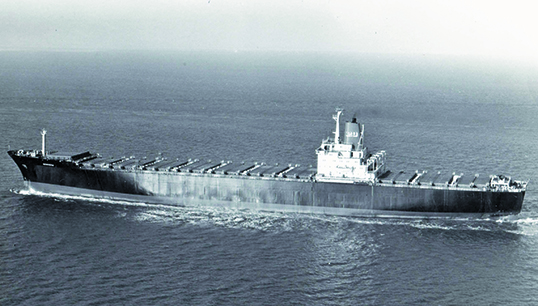
I have read with great interest your recent letters relating to the Bay class of steam-driven container ships. I myself never sailed onboard any of these ships, but I did have several voyages as 4th engineer on the Remuera, which later became the Remuera Bay.
Relating to its top speed: after I joined the vessel during the last three months of constructions at the Walker yard on the Tyne, the ship completed sea trials. I cannot remember the top speed over the measured mile, but it was certainly very fast, and was classed by Lloyd’s as the largest and fastest refrigerated containership in the world (1974/75). The fuel consumption at this sort of speed was horrendous and the service speed was reduced to 23 knots in the interest of economy.
They were well-designed and constructed ships, and all was well with the ‘Rem’ until she went for her guarantee dry dock in Rotterdam – which is where the shipyard returned the HP turbines back from shoreside inspection and placed the port TP turbine into the starboard engine and vice versa. From leaving the yard to entering the North Sea, the LP Turbine Hoods had changed colour from a light magnolia to a dark chocolate brown because of all the live steam entering the condenser. Why we did not turn around and go back in, I will never know, but the commercial pressures to start the next voyage must have been enormous.
Things went from bad to worse, and by the time we hit the Australian coast, the evaporators could not keep pace with the boiler water lost from all the leaks. The entire steam system was flooded with various oxides, which coated the turbine blades, which cased the feed pumps and turbo alternators to trip every few days. Blackouts were a regular occurrence. We even had to buy tanker loads of distilled water from local power stations.
On the return voyage, we resorted to draining the air conditioning and cargo refrigeration systems for water so that we could at least have a strip-down wash once a day – all home-made water went to the boilers. The ship eventually reached Monrovia, where it completely shut down.
It was a standing joke amongst the engineers at the time that you could gain more knowledge and experience doing one watch on the Rem than you would get completing 10 years on a normal vessel. Passing EK and oral steam exams was a doddle after that voyage.
A testament to the quality of the design and construction of the vessel was that she could absorb so much punishment and survive to complete many more profitable voyages.
Her power point consisted of two foster wheeler ESD III water tube boilers driving 2x2 sets of GEC turbines through twin screws producing 48,000 SHP, single-handed watches.
1977 – renamed Remuera Bay
1983 – re-engined with a 2SA 9cyl Sulzer Diesel at 29610 BHP modified to a single screw – service speed 20 knots
1993 – renamed Berlin Express
2002 – renamed Press
June 2002 – broken up in China
Michael Bond
More letters
It’s never right to attack civilian seafarers
I was saddened to see the footage of the attack by Ukraine on the two tankers in the Black Sea on 29 November. My heart goes out to the crew and officers who are, in my mind, not combatants in the Russia/Ukraine war.
There's no crisis in the yacht sector
I read Rob Coston's interview with yacht sector recruitment agent Max Lee on your website and found it sensationalist. In my opinion, it incorrectly described the situation regarding safety in yachting as a 'crisis'.
Expertise needed for my student cybersecurity survey
I am a first-year cadet, with experience as a rating, who is conducting a survey on the shipside adaptation of cybersecurity practices, and I would be extremely grateful if fellow Nautilus members could complete a short survey for me.
